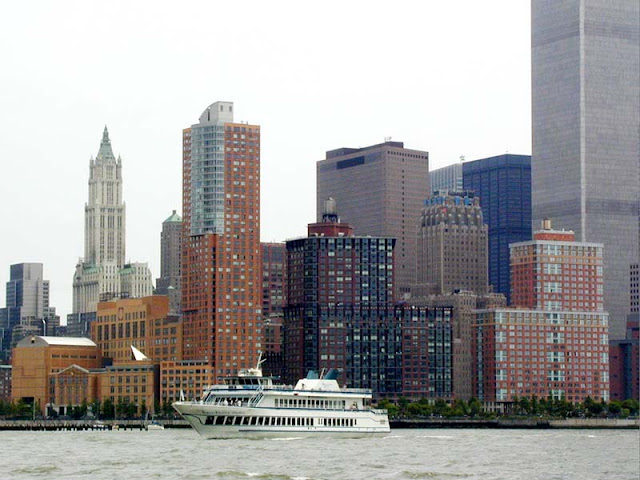Thursday, June 4, 2009
Tribeca: Jimmy J. Aquino's Lacuna Matata, Part 1
This is the first in a series of posts I'm calling "Lacuna Matata," in which I attempt to preserve the fading memory of TV shows (or in some cases, comic books) that no one except me remembers watching because the networks somehow Lacuna'd these things from everyone's noggins.
Buried somewhere in my old VHS collection at my parents' house is a tape in shabby condition that contains the Young Indiana Jones Chronicles episode that guest-starred Harrison Ford and the first two episodes of Tribeca, a pretty good, rarely seen 1993 anthology series that was filmed on location in New York and lasted only seven weeks on Fox.
A decade before Robert De Niro and his Tribeca Productions business partner Jane Rosenthal co-founded the Tribeca Film Festival, the two producers used the Lower Manhattan neighborhood as the setting for what was essentially a throwback to the highbrow '50s and '60s TV dramas that were made during "a time when socially-conscious New Yorkers ruled the airwaves," as Maclean's' Jaime J. Weinman describes the New York-centric early years of scripted TV. That somber, East Side/West Side-esque approach meant this anthology drama, which focused on a different Tribeca resident or two each week, fit right in on the Simpsons and Married... with Children network's schedule about as well as Carrie Prejean at an opposite couples pride parade.
There are two things I saw while growing up that made me think to myself, "Wow, despite the cockroaches and occasional muggers, New York ain't such a bad place after all and I want to move there someday": Ghostbusters and Fox's Tribeca. The show also gave me my first glimpse of Kevin Spacey, who guest-starred as a suicidal singer/songwriter--and got to show off his singing voice--in an episode that reunited him with Tribeca showrunner David J. Burke, who previously co-created the classic Wiseguy arc that gave Spacey his big break. Burke's taste for downbeat, untidy endings--a frequent element of his writing on Wiseguy--also gave Tribeca at the time a certain edge over network dramas not called Homicide.
Though it was an anthology show, Tribeca had a two-man regular cast (Philip Bosco as a kindly coffeehouse owner and Joe Morton as an equally kindly patrolman who looked like he came from Law & Order: Mounted Police Unit) and some nice bits of continuity (a character like a homeless war vet played by Stephen Lang would briefly appear one week and then turn up as the main character the following week). Like many other anthologies, Tribeca didn't always hit one out the park, but when it did, it was network TV at its best. The series' strongest episode was the first one, "The Box," which featured a standout Emmy-winning performance by a fresh-off-Boyz N the Hood Laurence Fishburne as a plainclothes cop who's obsessed with both finding the mugger who killed his stockbroker brother (Carl Lumbly) and opening a puzzle box that his brother gave to him before he died.
With its all-black guest cast, "The Box" is also a great 45-minute argument for the need for more network drama series with casts that consist mostly of actors of color. It's a shame that the five networks have been willing to take a chance on all-black sitcoms but not all-black dramas, possibly because of the low ratings of past dramas like Avery Brooks' A Man Called Hawk, James Earl Jones' Under One Roof and Blair Underwood's City of Angels. Sixteen years after its initial broadcast, "The Box" is sadly, still a rarity rather than the norm.
I remember seeing the reclusive De Niro make a surprise appearance in a Fox promo a la John Wayne's 1955 Gunsmoke series premiere intro to get Fox viewers to tune in to his show. No such luck. One other thing I remember about Tribeca was its cool opening and closing theme, an instrumental version of "Keep It Goin'," a James Brown-sampling 1992 track by largely forgotten alt-rap artist and A.V. Club "Least Essential Albums of the '90s" nominee Me Phi Me.
Tribeca is such an obscure series that there are no YouTube clips or .jpgs from the series online (the only pictures that turn up in Google image searches for Tribeca are pics of either De Niro or the neighborhood skyline). So as you listen to the Me Phi Me tune (that is if you can find it online), just stare at the photo of the Tribeca skyline at the top of this post, and you'll get a pretty accurate recreation of the Tribeca opening titles, which consisted of nothing but whip pans across the Tribeca streets and skyline. If you want to see whip pans, just hit yourself in the head with a skillet.
Subscribe to:
Post Comments (Atom)


No comments:
Post a Comment